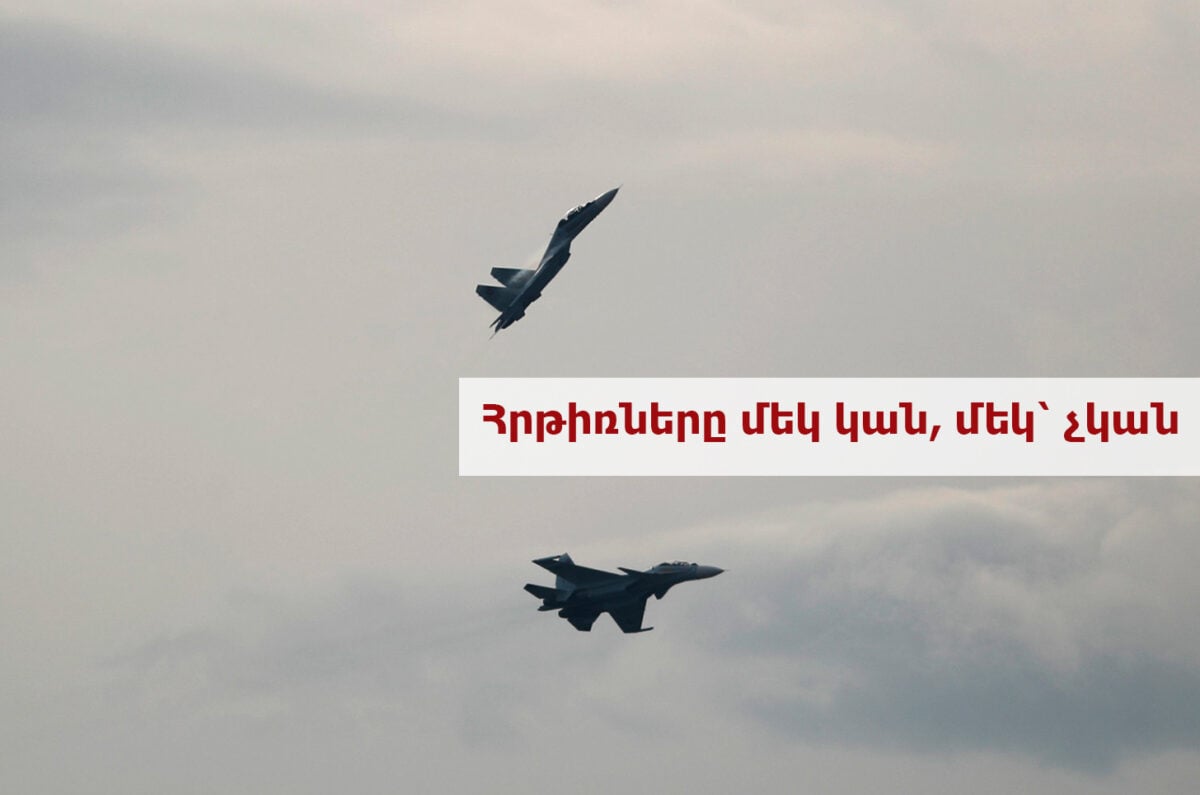
Prime Minister Pashinyan, contradicting himself, stated that Armenia did not manage to buy missiles intended for Su-30SM fighters. This statement made us remember the press conference of the former head of the General Staff Movses Hakobyan, who a few months ago claimed that Armenia had bought the fighters in vain, as their missiles were banned from being exported to Russia.
Media.am found out that there is contradictory or inaccurate information in the words of Pashinyan and Hakobyan.
Armenian Su-30SMs used unguided missiles
During his speech in the Ohanavan community on March 20, Prime Minister Nikol Pashinyan stated that Armenia had not managed to acquire missiles for Su-30SM fighters (in the video from 19:30)․ “Yes, we acquired the plane, the plane arrived in May, and yes, we did not manage to get the missiles before the war. Why didn’t you buy the planes so that we could have delivered the missiles as well?”
Several media outlets noted that Pashinyan’s words contradicted his previous statement.
2020 On July 3, Pashinyan wrote on his Facebook page, “Our Su-30SMs carried out the first training flights with a ‘combat wound’ yesterday, testing air-to-ground missiles for ‘attack operation.'” The video published by Pashinyan really shows the missiles attached to the Su-30SM.
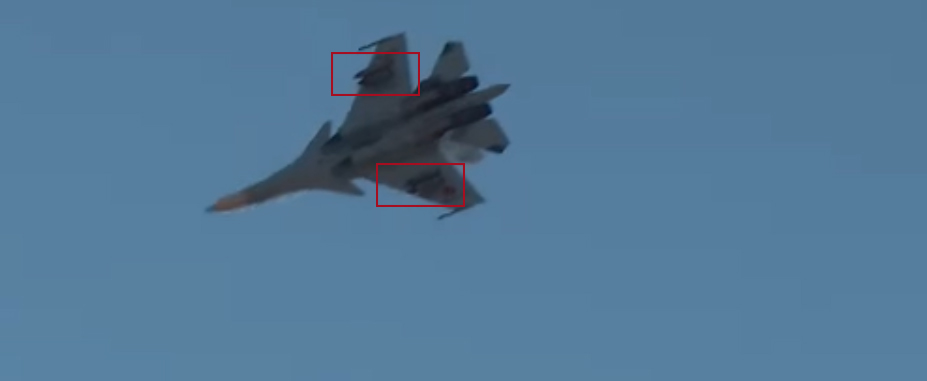
The spokesperson for the Ministry of Defense Ministry, Shushan Stepanyan, also said that different types of missiles were used during the exercises.
Su-30SMs can use different types of ammunition: Aircraft bombs, unguided missiles and guided missiles. The latter can hit targets in the air (“air-to-air”) or on the ground (“air-to-ground”).
Military analyst Hayk Khachikyan told us that in the video published by Pashinyan, the use of unmanned aerial missiles was seen, and not guided “air-to-ground” missiles, as Pashinyan claimed.
There are missiles in the arsenal of Armenia. In this video published in 2019, the Б-8М1 block is seen on the Su-25 attackers of the Armenian Armed Forces, from which unguided aircraft missiles are fired.
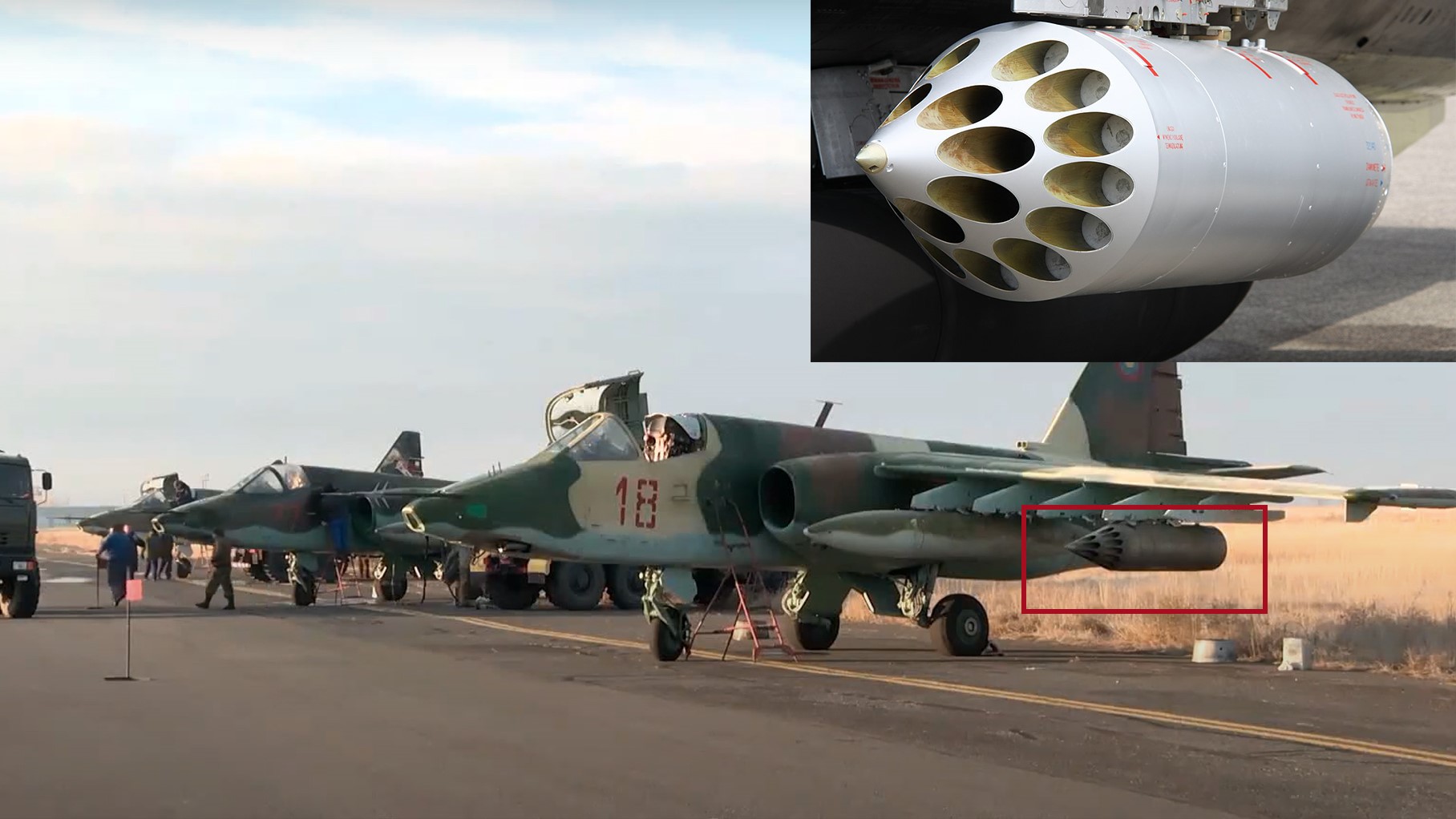
The Б-8М1 unit launching unguided missiles hanging on the wing of the Armenian Su-25. Photos by Armed Media, konflikty.pl/Wikipedia.
In the same video, you can also see the use of missiles not controlled by Su-25s.
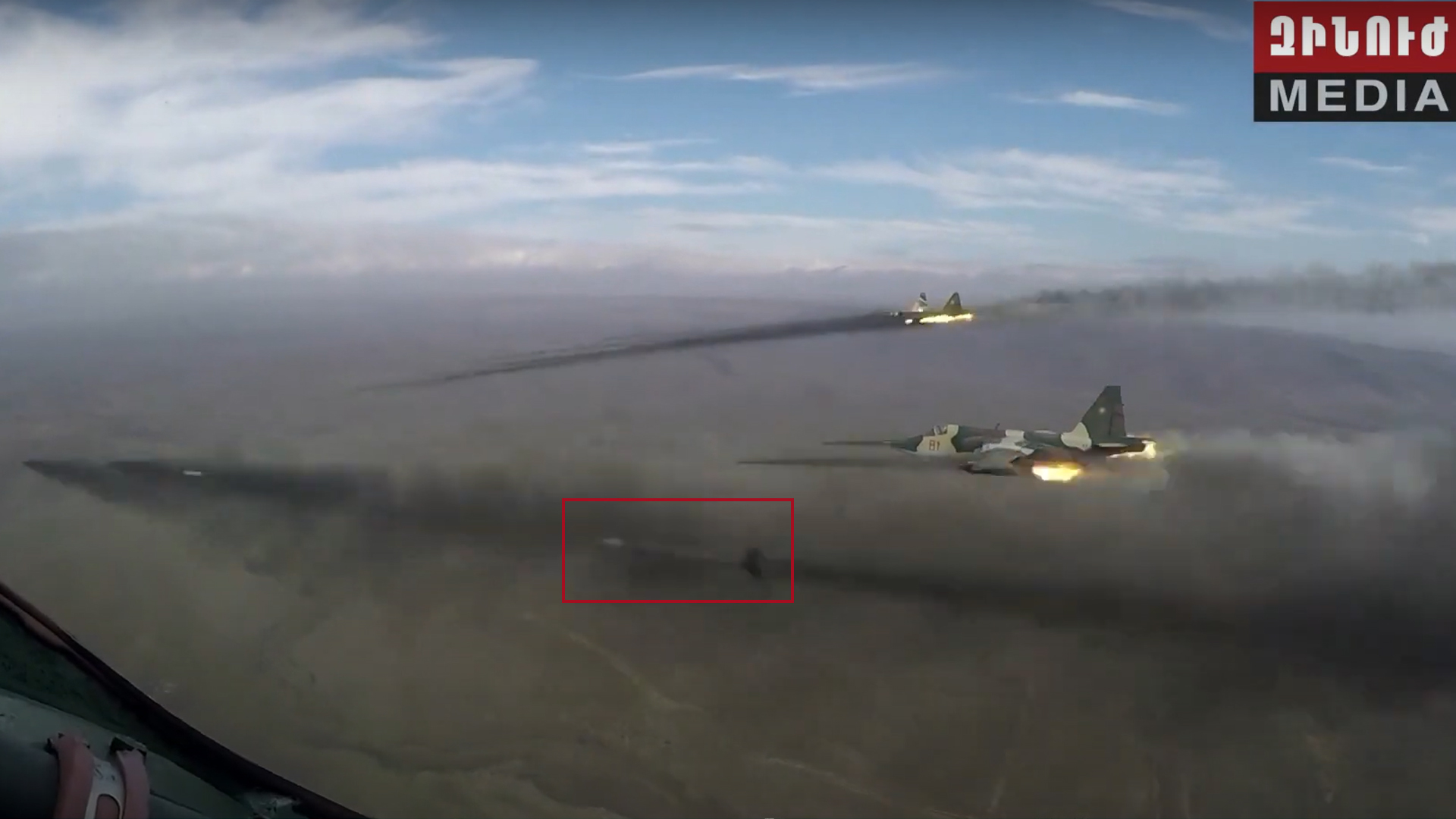
Armenian Su-25 attackers fire missiles during military exercises. Photo: Armed Media.
Furthermore, in 2016 Armenia presented its own unmanned missiles at the ArmHighTech armament exhibition.
Thus, the Prime Minister’s words are contradictory. First, Pashinyan did not detail what kind of missiles Armenia did not manage to buy. There are various types of unguided missiles in the Armenian arsenal, and Su-30SMs used them during military exercises.
In July last year, Pashinyan announced the use of “air-to-ground” missiles, although there is no evidence of their use in open sources. It is very probable that not “air-to-ground” but non-controlled air missiles in the Armenian arsenal were used that day.
It should be noted that there are also guided “air-to-air” missiles, which have not yet been used by Armenian Su-30SM fighters.
Former Chief of General Staff states that Armenia bought Su-30SMs without air-to-air missiles
Back in November last year, the former Chief of the General Staff of the Armed Forces Movses Hakobyan criticized the acquisition of Su-30SM fighters. According to Hakobyan, the Su-30SM fighters purchased from Russia were without ammunition, as Russia does not sell air-to-air missiles with a range of 130 km to another country, which is why our Sus were not used during the war.
“The current government cannot deny that it has acquired weapons without reading the decision of the Russian government that the ammunition will not be sold to them. The ammunition for which they were acquired, which advertise that it can fire anti-aircraft “air-to-air” missiles up to 130 km, is prohibited by the decision of the Russian government to sell the ammunition to a second country. And that is why our Sus are in the country today, without ammunition,” said Hakobyan.
There are several assertions in this statement:
? The Armenian government advertised that the Su-30SMs could fire air-to-air missiles with a range of 130 km.
? The Russian government has secretly banned the sale of 130 km long-range missiles to second countries.
? The Armenian authorities did not pay attention to this ban, that is why the fighters are standing without ammunition.
Russia produces various weapons for export and domestic use. For example, Iskander operational-tactical missile systems have Iskander M and Iskander E types, the first of which is for internal use only and is not exportable. However, we did not manage to find Such a barrier for Su-30SM 130 km air-to-air missiles.
Media.am asked Movses Hakobyan what decision of the Russian government is in question. Hakobyan replied that we could not see the decision because it was secret. According to him, there is a list of ammunition, which is forbidden to sell to another country. In the case of the Su-30, we are talking only about “air-to-air” missiles with a range of 130 km. Movses Hakobyan did not detail what kind of missiles he was talking about, noting that he did not have Such information.
“Air-to-air” missiles are small, medium and long-range. Movses Hakobyan was talking about a large “air-to-air” missile with a range of 130 km. Media.am, however, failed to find promises of the Armenian government to use missiles with a range of 130 km.
“Air-to-air” missiles of all distances (small, medium, large) intended for export from Russia can be found on the website of the state organization “Рособоронэкспорт” (“Рособоронэкспорт” is the state intermediary organization of the Russian Federation for export). It turns out that there is no ban in Russia on selling long-range missiles.
Su-30SM fighters can carry different types of bombs and missiles. Among them are R-77, R-73 and R-27 small and medium-range guided missiles and their improved versions.
The “air-to-air” missiles used on Su fighter jets have options for export.
In 2019, Russia had sold about 1,000 R-27 (up to 100 km), R-73E (up to 40 km) and R-77 (up to 110 km) missiles to India.
Iz.ru notes that India, in all probability, has chosen not one, but several improved versions of the missiles. Interfax reports that they will be used for Su-30 MKI fighters of the Indian Air Force.
Thus, Movses Hakobyan substantiates his claims about the 130 km long-range missiles with a secret document, at the same time noting that he does not know which missiles, in particular, he is talking about. Russia exports “air-to-air” missiles of all distances. The “air-to-air” missiles used in Su-30 fighters also have options for export. Moreover, although Movses Hakobyan claimed that the 130 km long-range missiles were “advertised,” such a promise of the government is not mentioned in open sources. It is also not clear from Movses Hakobyan’s words why Armenia should use 130 km with Su-30SMs and not other long-range missiles.
Cost of Su-30SMs
At one time, the acquisition of Su-30SMs was criticized because of the high cost of fighters. Let’s try to understand what it costs to buy this weapon and what its average market price is.
In September 2014, the Russian Ministry of Defense announced that it had signed a contract with the Irkut aircraft manufacturer for the sale of 7 Su-30SM aircrafts, as well as aircraft maintenance equipment. The total value of the contract was 13 billion rubles (about $360 million at the exchange rate at the time). It turns out to be about 51-52 million dollars for each plane. However, the amount paid is not intended only for weapons.
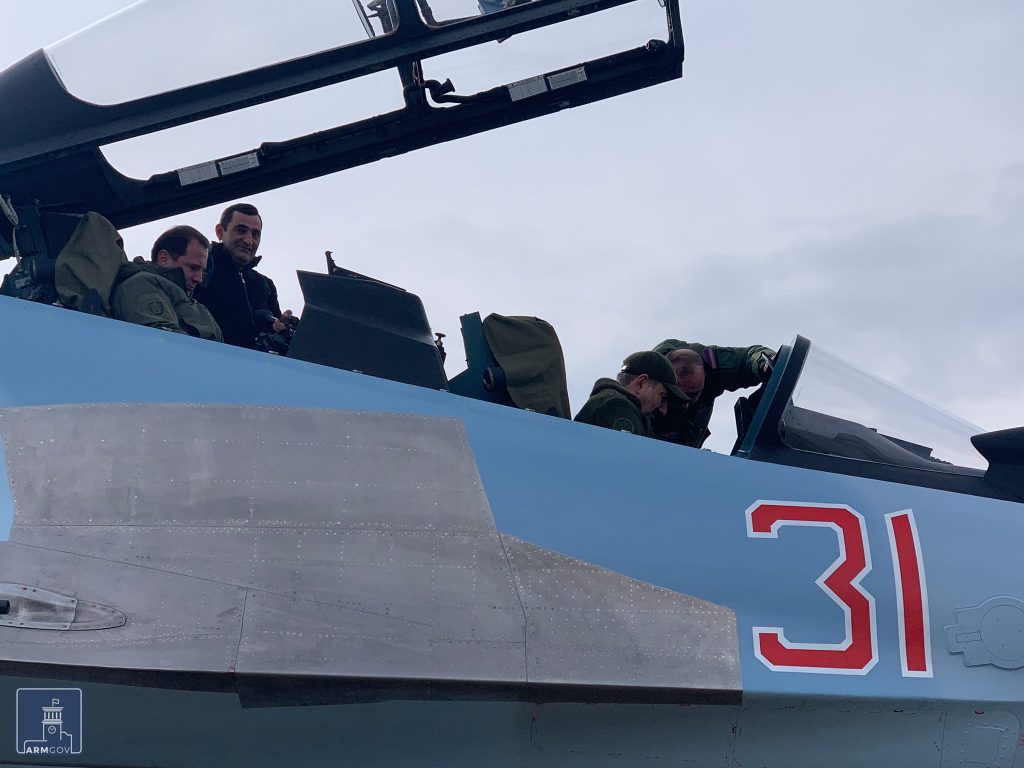
Nikol Pashinyan and Davit Tonoyan in a Su-30SM fighter. Photo: RA Government
Kazakhstan, for example, bought four Su-30SM4s in 2014 at a cost of 5 billion rubles (about $130 million), but various sources, including military journalist and photographer Grigory Bedenko, say the deal with Irkut also includes the training, technical supervision and service of Kazakh pilots.
In 2015, the latter announced the signing of a new contract, under which Kazakhstan acquired 6-7 units of Su-30SMs for 10 billion rubles (at an exchange rate of about $160 million).
In 2017, it became known that Belarus and Russia had signed an agreement on the purchase of 12 Su-30SM fighters manufactured by the Irkut plant. In 2019, it was announced that the first pair of fighters were already in Belarus. The cost of 12 fighters according to various estimates was $600 million. That is, each plane cost $50 million.
Sergei Tretiak, Deputy Director of the Irkut Corporation, which produces aircraft, once said that the equipment is sold within the CSTO at current prices for the Russian Armed Forces.
An hour of flight of both a Su-27 and Su-30 was estimated at 40 thousand dollars.
These examples show that the cost of one Su-30SM fighter can range from $25-50 million, not counting the additional equipment, crew (training and salary) and other costs required to operate the aircraft.
Karine Ghazaryan
Ophelia Simonyan

Add new comment
Comments by Media.am readers become public after moderation. We urge our readers not to leave anonymous comments. It’s always nice to know with whom one is speaking.
We do not publish comments that contain profanities, non-normative lexicon, personal attacks or threats. We do not publish comments that spread hate.